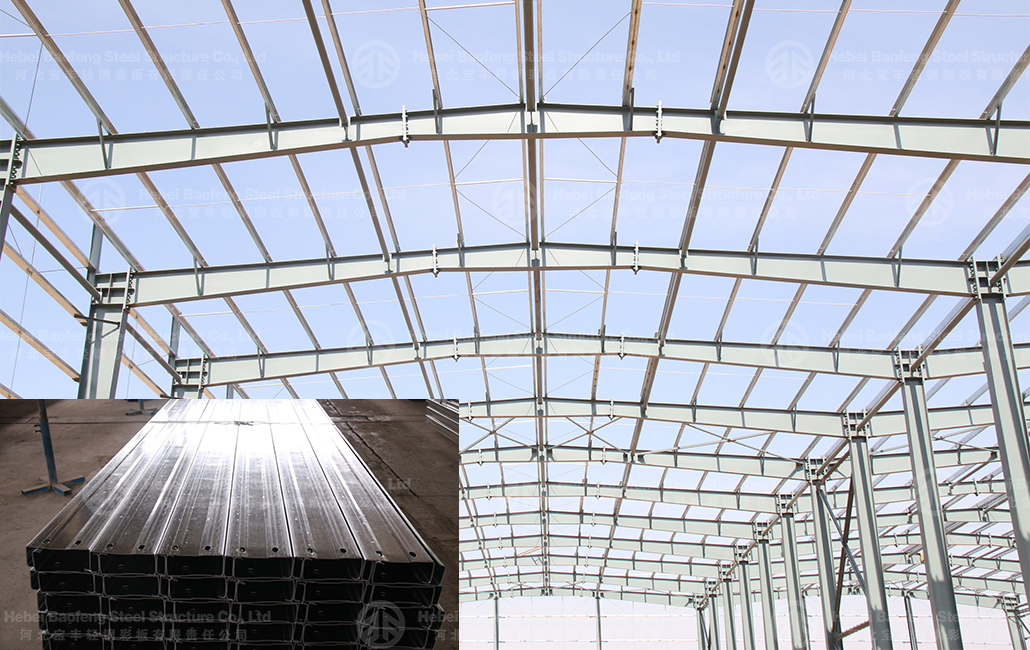
Why Purlins Are Important in Steel Structure Buildings?
Purlins play a critical role in steel structure buildings, serving as secondary structural components that directly support the roof and wall systems. Their importance lies in ensuring structural stability, load distribution, and overall building performance. Below is a detailed breakdown of their functions and key advantages:
1. Primary Functions of Purlins
① Roof Load Support
Primary Role: Purlins are horizontal beams installed on the roof trusses or main steel frames, directly supporting roofing materials (e.g., metal sheets, insulation panels).
Load Types: They bear dead loads (self-weight of roofing, snow) and live loads (maintenance personnel, wind uplift forces).
② Wall Load Support
In wall applications, purlins (often called "girts") are attached to vertical columns to support wall cladding (e.g., metal panels, glass) and resist wind pressure.
③ Structural Stability
Purlins work with roof trusses, columns, and bracing systems to distribute loads evenly, preventing deformation or collapse under stress.
2. Key Advantages of Using Purlins
① Lightweight & High Strength
Made from cold-formed steel (e.g., C-section or Z-section purlins), they offer high strength-to-weight ratios, reducing the overall load on the main steel frame.
Easy to transport, handle, and install compared to heavier materials like timber or concrete.
② Cost-Effective & Fast Installation
Prefabricated to standard sizes, minimizing on-site cutting and welding.
Quick assembly with bolts or self-drilling screws, significantly reducing labor costs and construction time.
③ Flexibility in Design
Adjustable Spacing: Purlins can be spaced (typically 1.2m–2.4m apart) to accommodate different roofing materials and load requirements.
Compatibility: Works with various roofing systems (standing seam, corrugated sheets) and wall cladding.
④ Enhanced Durability
Corrosion Resistance: Galvanized or painted coatings protect against rust, ensuring longevity in harsh weather.
Sustainable: 100% recyclable, aligning with green building standards (LEED, BREEAM).
3. Types of Purlins & Their Applications
| Type | Shape | Best For | Advantage |
|
C-Purlins |
C-shaped |
Roof and wall support |
Simple design, cost-effective |
|
Z-Purlins |
Z-shaped |
Multi-span roofs, overlapping joints |
Higher load capacity, better stiffness |
|
Sigma Purlins |
S-shaped |
High-wind or seismic zones |
Enhanced structural performance |
4. Why Purlins Matter in Steel Structure Buildings
①Load Distribution: Prevents concentrated stress on the main frame, extending the building’s lifespan.
②Roof Integrity: Maintains roof flatness and prevents sagging or water pooling.
③Wind & Snow Resistance: Reinforces the structure against environmental loads (critical in hurricane/avalanche zones).
④Modular Expansion: Simplifies future expansions by adding new purlin bays without redesigning the entire frame.
5. Common Mistakes to Avoid
①Incorrect Spacing: Over-spacing purlins leads to roofing sagging or collapse under heavy loads.
②Poor Fastening: Loose bolts/screws compromise stability during wind or seismic events.
③Ignoring Coatings: Unprotected steel purlins rust quickly in humid/coastal environments.
Conclusion
Purlins are the backbone of steel roof and wall systems, ensuring structural integrity, cost efficiency, and long-term durability. Proper selection (type, spacing, coatings) and installation are critical to maximizing their performance.

Categories
latest blog
Tags